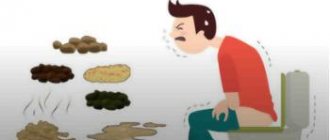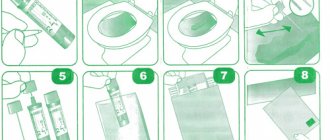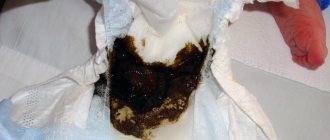What should a newborn's stool look like?
The nature of bowel movements changes with age. The older a child gets, the more his stool resembles an adult's stool.
0–1 month
A child’s stool at this age is transitional, that is, it goes through the stage of formation from meconium to mature. A change in the nature of feces is normal for this age.
During the first 12 hours after birth, the baby should have a bowel movement. The first stool is called meconium. It consists of epithelial cells that line the baby’s intestines; it is a mucus plug, so it has a specific appearance. This is a thick viscous dark green or almost black mass, similar to tar. The volume is small, but it is very difficult to wash it off the baby’s body.
The child empties with meconium for 1–2 days until the intestinal microflora is formed. On the third day, the stool changes. Its characteristics:
- frequent, up to 6–10 times a day;
- heterogeneous, with lumps, mucus;
- watery;
- with a sour odor;
- green-yellow, yellow-green, sometimes even whitish.
This is a transitional stool that gradually returns to normal with the appearance of milk in a woman. After 1–2 weeks it becomes homogeneous, mushy, not so liquid, yellow in color.
During the period of formation of intestinal microflora and normalization of the functioning of the gastrointestinal tract, there is a possibility of constipation, so a woman should carefully monitor her diet and not eat foods that have a binding effect.
A one-month-old baby's stools are mature. Its characteristics:
- yellow or yellow-golden hue;
- homogeneous consistency;
- absence of large amounts of mucus and other impurities;
- sour smell;
- stool is frequent, the child should poop up to 6–12 times, on average 4–6 times;
- volume of feces – 5–10 g.
It is not uncommon for one-month-old babies to have watery stools.
2–3 months
The norm for babies of this age is mature feces. It should not be watery or too runny, but not yet formed.
Why does infants have mucus in their stool →
Characteristics of baby's stool:
- consistency of thick sour cream;
- bright yellow color;
- with a sour odor;
- the volume of feces during one emptying is up to 15–20 g.
If the feces correspond to the norm, then this indicates normal absorption of food and maturation of the digestive tract. The child does not need to be supplemented or fed.
4–6 months
The frequency of stool changes and it becomes less frequent. A child can defecate up to 2–5 times a day, more often in the morning; the volume of single bowel movements increases to 40–50 g.
The feces remain yellow, with a mushy consistency, more formed, but not the same as in adults. Constipation may occur when introducing complementary foods.
So, to summarize, the frequency and volume of feces in children under 6 months are within normal limits:
| Age | Stool volume | Frequency of bowel movements per day |
| up to 1 month | 5 g | 6–10 |
| 1 month | 5–10 g | 4–6 |
| 2–3 months | 15–20 g | 4–6 |
| 4–6 months | 40–50 g | 2–5 times |
Yellow stool in a breastfed baby
When feeding a baby exclusively with breast milk, the nuances of stool color can vary from yellow, of varying saturation, to greenish and brownish. Yellow stool in a breastfed baby smells like sour milk, with a faint sweetish tint, and has a porridge-like consistency of thick sour cream. If, despite the normal color of the feces, the baby’s stool is liquid and foamy, and its smell changes, the mother should be wary. Restless behavior, whims when eating, and some weight gain indicate a deficiency of hindmilk in the infant’s diet. This milk is higher in calories and contains substances that help break down milk sugar.
Characteristics of stool during breastfeeding
The stool of a breastfed newborn differs from the stool of bottle-fed babies. What is normal for some is a sign of pathology for others. Let's look at what a normal newborn's stool looks like during breastfeeding.
Color
A newborn who is on breastfeeding has yellowish-golden stool. Deviations from the norm indicate the following pathologies:
- green feces in a child – dysbacteriosis, intestinal infection, indigestion;
- white – jaundice;
- black – bleeding from the upper gastrointestinal tract.
A greenish tint to the stool may be normal for babies in the first month of life, but if the consistency is watery, this indicates an immature digestive system and insufficient liver development. If the child does not outgrow the condition over time, treatment will be required.
Smell

During normal functioning of the gastrointestinal tract, stool will have a sweetish odor, reminiscent of milk, or sour, like cottage cheese. A specific smell indicates fermentation in the intestines, poor digestion, infectious diseases, and dysbacteriosis.
Consistency
The norm for a baby is mushy stool. The consistency will change with age. A child up to 1 month has loose, watery stool, then it becomes thicker, more formed, and resembles a thick paste.
The older the baby gets, the thicker the stool becomes.
Foamy stool in an infant indicates dysbiosis, intestinal infections or lactase deficiency. Watery liquid feces in babies closer to six months of age may appear during periods when teeth are being cut. This is the norm.
Loose stools in infants →
Impurities
Feces with mucus, white lumps, pieces of food and even streaks of greenery are the norm for children in the first year of life, at least up to 7 months. This is an indicator of the formation of intestinal microflora and a sufficient number of enzymes. As soon as the digestion process improves, the feces will be free of impurities. But the discharge should not contain blood or purulent inclusions.
Too much mucus with streaks in the stool of a baby indicates a lack of enzymes, infections, allergies, and malnutrition.
Frequency
How many times a baby poops depends on his age:
- at 1–2 months, stool frequency is directly proportional to the number of feedings;
- at 3–4 months the baby poops 2–4 times, often at the same time.
If the frequency of bowel movements exceeds 7-10 times, and the stool is like water, then this is diarrhea. To normalize stool, sometimes it is enough to adjust the mother’s diet.
If a child does not poop for a long time, that is, the frequency of bowel movements is low, this indicates a low calorie diet or constipation.
Types of yellow stool in infants and their causes
The ideal stool for a baby is a stool of uniform consistency, yellow and free of foreign impurities. The types of yellow stool in infants and their causes may change during growth. In the first week of life, a baby may have dark green stools. It will take some time for the baby's body to adapt to mother's milk, and the stool will acquire a normal color. Normal functioning of the intestinal tract (on average) is formed within 5 months. After six months, the baby’s diet will be varied with complementary foods. Grated beets and carrots can give stool shades ranging from red to orange. When giving a child iron-containing preparations or activated carbon, the mother should be prepared for the appearance of black streaks in the stool. A very light-colored baby stool may be a sign of dysbiosis or indicate the appearance of the first tooth.
Yellow-green stool in infant
Prolonged physiological jaundice of a newborn can cause yellow-green stools; an excess of bilirubin in the bile ducts affects the color of the baby’s stool. If the baby is breastfed by the mother, she needs to monitor her diet; eating a large amount of greens will turn the baby’s stool yellow-green. But, the baby’s digestion process is just beginning to establish itself; the cause of the appearance of a greenish color may be problems with the intestinal tract; if you are not sure, it is best to consult a specialist.
Yellow-white stool in infant
Changes in the diet of a nursing mother towards the consumption of fatty and sweet foods cause lightening of the baby's stool. Yellow-white stool in a baby can be a consequence of the mother's consumption of any medications. When a white enzyme appears in the baby’s stool, the parents think about hepatitis; this is the main, pronounced symptom of the disease. However, it is worth remembering that this disease is accompanied by abdominal pain and a gag reflex; the child’s urine becomes very dark.
Yellow stool with mucus in an infant
The presence of mucus in a baby's stool often worries the mother. The presence of small mucous secretions indicates healthy digestion; a sharp increase in the amount of mucus indicates nutritional disturbances and the occurrence of serious diseases. It should be borne in mind that with a common runny nose, mucus passes into the intestinal tract and is excreted with feces. Yellow stool with mucus may appear in a baby if the baby is not breastfed correctly. It is important for a young mother to remember that the baby must suck all the milk from one breast; hind milk provides the baby with the necessary lactose enzyme, which facilitates the digestion of mother’s milk.
Yellow foamy stool in an infant
The appearance of foamy formations in the stool of an infant is often a sign of a functional disorder and is unlikely to be associated with any pathology or serious disease. If the child is active and has no other symptoms, the reason lies in the mother’s diet or new complementary feeding products. Yellow, foamy stool in an infant, with elements of mucus and a greenish tint, can be provoked by nutritional experiments; foaming is the result of fermentation in the child’s intestines. A nursing mother should limit her consumption of raw vegetables, especially cabbage, and should not overuse chicken eggs and carbonated drinks.
Yellow lumpy stool in infant
You can find cheesy lumps in the baby's stool, which indicate incomplete digestion of food. This usually happens in the first months of life; the baby cannot quickly adapt to the high fat content of mother's milk. Stool with yellow lumps in a baby can signal overeating; the amount of food is not absorbed by the baby, is not digested and comes out in lumps. A baby fed on the mother's breast does not overeat; the process of sucking milk itself takes much more physical effort from the baby than feeding through a nipple. Mothers who artificially feed their infants should carefully monitor the qualitative and quantitative composition of the formula.
Features for different types of feeding
The nature of bowel movements depends on the type of feeding. Children who receive a mixed diet or eat exclusively formula have slightly different bowel movements.
Artificial feeding
Formula-fed babies stool less frequently. By the end of the first month of life, a newborn can have bowel movements only 2-3 times a day.
Formula is harder to digest than milk, so formula-fed children often suffer from constipation. It is important to choose the right diet. For problems with the gastrointestinal tract, fermented milk mixture is suitable.
Characteristics of bottle-fed stool:
- the baby poops rarely, 1–2 times a day, but regularly;
- stool is thick;
- the color is dark yellow, from the age of 3–4 months – brown;
- volume of feces – 30 g.
There should be no blood, blood streaks, or pus in the stool. A small amount of mucus and white crumbs is acceptable. After the introduction of complementary foods, the feces form into a soft sausage.
Green stool in a bottle-fed baby can also be normal. It is inherent in babies who consume hydrolyzed or partially split protein. Feces not only change color, but also acquire a specific smell.
However, it is not foamy, not watery, and does not consist of pieces of undigested food. These are all signs of pathologies.
If the baby uses a regular, non-medicinal formula, and his stool is green, then it is more likely that he has dysbiosis.
Read more about green stool in your baby →
Mixed feeding

The type of stool depends on the proportion of breast milk and formula in the child’s diet. It may approach normal bowel movements when breastfed or bottle-fed.
With mixed feeding, what is more important is not how the stool looks, but how the baby feels.
Characteristics of feces:
- frequency from 3 to 10 times a day, the more milk he drinks, the more often he poops;
- slightly sour smell, not offensive;
- mushy consistency or loose stools if the baby receives more breast milk than formula;
- color from yellow to light brown.
How much should a child under one year old poop →
Any changes in the nature of a newborn's stool should cause concern to parents, especially if nothing preceded this. Constipation and diarrhea are often the result of introducing new foods into the diet or disrupting the feeding regime. These conditions can be easily corrected at home. But more serious problems, such as dysbiosis, require medical attention.
The norm of stool for children of the first year of life has expanded boundaries; many factors influence the characteristics. It is important to understand what is normal for your child and evaluate bowel movements based on this.
Photo: ru.freepik.com









